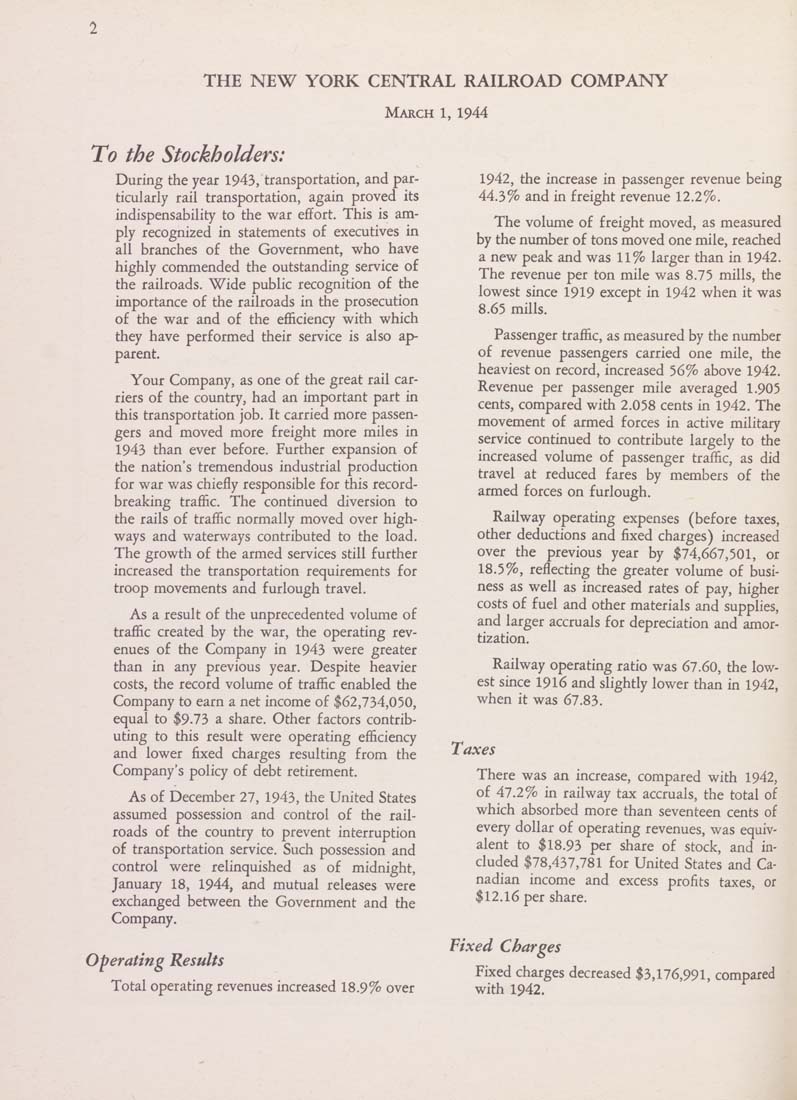THE NEW YORK CENTRAL RAILROAD COMPANY
March 1, 1944
To the Stockholders:
During the year 1943, transportation, and par¬
ticularly rail transportation, again proved its
indispensability to the war effort. This is am¬
ply recognized in statements of executives in
all branches of the Government, who have
highly commended the outstanding service of
the railroads. Wide public recognition of the
importance of the railroads in the prosecution
of the war and of the efficiency with which
they have performed their service is also ap¬
parent.
Your Company, as one of the great rail car¬
riers of the country, had an important part in
this transportation job. It carried more passen¬
gers and moved more freight more miles in
1943 than ever before. Further expansion of
the nation's tremendous industrial production
for war was chiefly responsible for this record-
breaking traffic. The continued diversion to
the rails of traffic normally moved over high¬
ways and waterways contributed to the load.
The growth of the armed services still further
increased the transportation requirements for
troop movements and furlough travel.
As a result of the unprecedented volume of
traffic created by the war, the operating rev¬
enues of the Company in 1943 were greater
than in any previous year. Despite heavier
costs, the record volume of traffic enabled the
Company to earn a net income of $62,734,050,
equal to $9.73 a share. Other factors contrib¬
uting to this result were operating efficiency
and lower fixed charges resulting from the
Company's policy of debt retirement.
As of December 27, 1943, the United States
assumed possession and control of the rail¬
roads of the country to prevent interruption
of transportation service. Such possession and
control were relinquished as of midnight,
January 18, 1944, and mutual releases were
exchanged between the Government and the
Company.
Operating Results
Total operating revenues increased 18.9% over
1942, the increase in passenger revenue being
AA.'i^o and in freight revenue 12.2%.
The volume of freight moved, as measured
by the number of tons moved one mile, reached
a new peak and was 11% larger than in 1942.
The revenue per ton mile was 8.75 mills, the
lowest since 1919 except in 1942 when it was
8.65 mills.
Passenger traffic, as measured by the number
of revenue passengers carried one mile, the
heaviest on record, increased 56% above 1942.
Revenue per passenger mile averaged 1.905
cents, compared with 2.058 cents in 1942. The
movement of armed forces in active military
service continued to contribute largely to the
increased volume of passenger traffic, as did
travel at reduced fares by members of the
armed forces on furlough.
Railway operating expenses (before taxes,
other deductions and fixed charges) increased
over the previous year by $74,667,501, or
18.5%, reflecting the greater volume of busi¬
ness as well as increased rates of pay, higher
costs of fuel and other materials and supplies,
and larger accruals for depreciation and amor¬
tization.
Railway operating ratio was 67.60, the low¬
est since I9I6 and slightly lower than in 1942,
when it was 67.83.
Taxes
There was an increase, compared with 1942,
of 47.2% in railway tax accruals, the total of
which absorbed more than seventeen cents of
every dollar of operating revenues, was equiv¬
alent to $18.93 per share of stock, and in¬
cluded $78,437,781 for United States and Ca¬
nadian income and excess profits taxes, or
$12.16 per share.
Fixed Charges
Fixed charges decreased $3,176,991, compared
with 1942.
|








